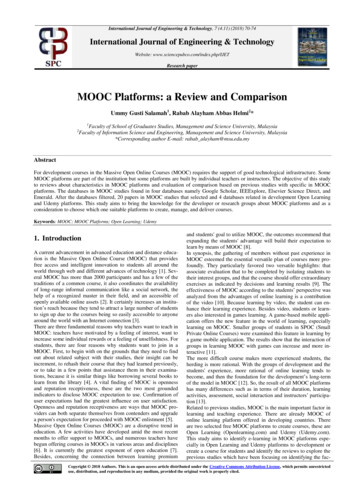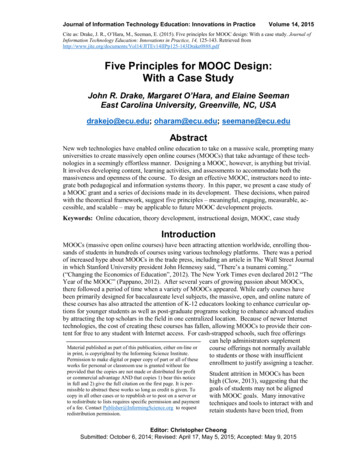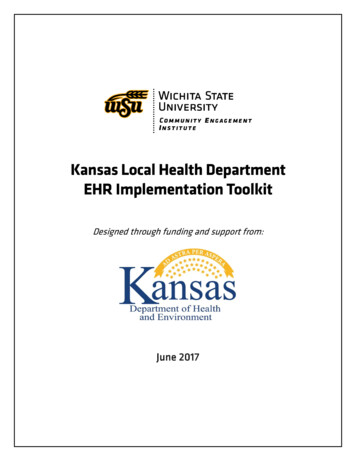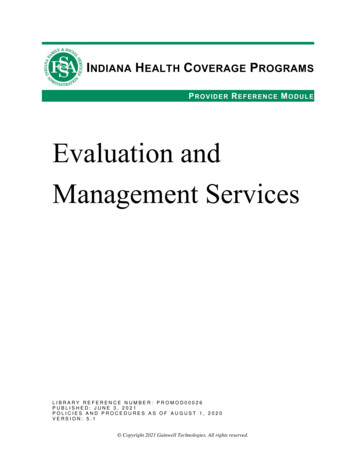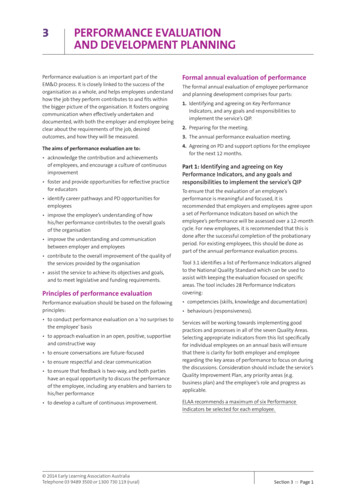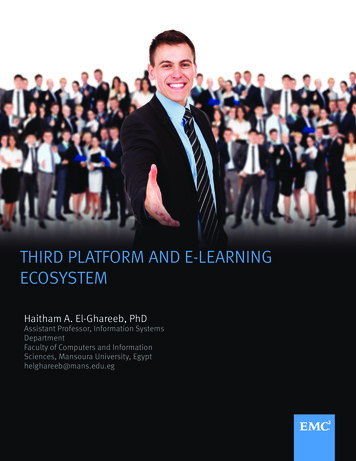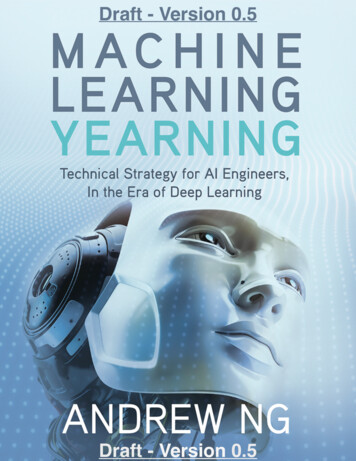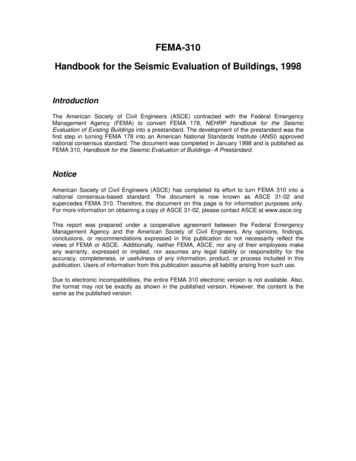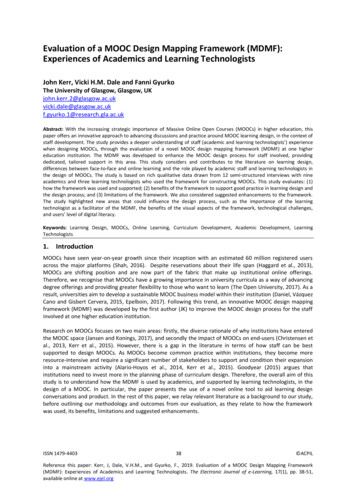
Transcription
Evaluation of a MOOC Design Mapping Framework (MDMF):Experiences of Academics and Learning TechnologistsJohn Kerr, Vicki H.M. Dale and Fanni GyurkoThe University of Glasgow, Glasgow, kf.gyurko.1@research.gla.ac.ukAbstract: With the increasing strategic importance of Massive Online Open Courses (MOOCs) in higher education, thispaper offers an innovative approach to advancing discussions and practice around MOOC learning design, in the context ofstaff development. The study provides a deeper understanding of staff (academic and learning technologists') experiencewhen designing MOOCs, through the evaluation of a novel MOOC design mapping framework (MDMF) at one highereducation institution. The MDMF was developed to enhance the MOOC design process for staff involved, providingdedicated, tailored support in this area. This study considers and contributes to the literature on learning design,differences between face-to-face and online learning and the role played by academic staff and learning technologists inthe design of MOOCs. The study is based on rich qualitative data drawn from 12 semi-structured interviews with nineacademics and three learning technologists who used the framework for constructing MOOCs. This study evaluates: (1)how the framework was used and supported; (2) benefits of the framework to support good practice in learning design andthe design process; and (3) limitations of the framework. We also considered suggested enhancements to the framework.The study highlighted new areas that could influence the design process, such as the importance of the learningtechnologist as a facilitator of the MDMF, the benefits of the visual aspects of the framework, technological challenges,and users’ level of digital literacy.Keywords: Learning Design, MOOCs, Online Learning, Curriculum Development, Academic Development, LearningTechnologists1.IntroductionMOOCs have seen year-on-year growth since their inception with an estimated 60 million registered usersacross the major platforms (Shah, 2016). Despite reservations about their life span (Haggard et al., 2013),MOOCs are shifting position and are now part of the fabric that make up institutional online offerings.Therefore, we recognise that MOOCs have a growing importance in university curricula as a way of advancingdegree offerings and providing greater flexibility to those who want to learn (The Open University, 2017). As aresult, universities aim to develop a sustainable MOOC business model within their institution (Daniel, VázquezCano and Gisbert Cervera, 2015, Epelboin, 2017). Following this trend, an innovative MOOC design mappingframework (MDMF) was developed by the first author (JK) to improve the MOOC design process for the staffinvolved at one higher education institution.Research on MOOCs focuses on two main areas: firstly, the diverse rationale of why institutions have enteredthe MOOC space (Jansen and Konings, 2017), and secondly the impact of MOOCs on end-users (Christensen etal., 2013, Kerr et al., 2015). However, there is a gap in the literature in terms of how staff can be bestsupported to design MOOCs. As MOOCs become common practice within institutions, they become moreresource-intensive and require a significant number of stakeholders to support and condition their expansioninto a mainstream activity (Alario-Hoyos et al., 2014, Kerr et al., 2015). Goodyear (2015) argues thatinstitutions need to invest more in the planning phase of curriculum design. Therefore, the overall aim of thisstudy is to understand how the MDMF is used by academics, and supported by learning technologists, in thedesign of a MOOC. In particular, the paper presents the use of a novel online tool to aid learning designconversations and product. In the rest of this paper, we relay relevant literature as a background to our study,before outlining our methodology and outcomes from our evaluation, as they relate to how the frameworkwas used, its benefits, limitations and suggested enhancements.ISSN 1479-440338 ACPILReference this paper: Kerr, J, Dale, V.H.M., and Gyurko, F., 2019. Evaluation of a MOOC Design Mapping Framework(MDMF): Experiences of Academics and Learning Technologists. The Electronic Journal of e-Learning, 17(1), pp. 38-51,available online at www.ejel.org
John Kerr, Vicki H.M. Dale and Fanni Gyurko2.Literature reviewFor a deeper understanding of the MOOC design process, it is important to consider and summarise theresearch on the differences between online and face-to-face design, curriculum design, learning designframeworks, and the role of academic staff and learning technologists in the design process.MOOC design differs from the standard approach to online course design, with the vast difference in cohortsize and level of subject knowledge being the main differences (Jansen, Rosewell and Kear, 2017). Pedagogicalissues arise when educators need to change their mindset from face-to face and online courses (Hill, 2012)since in MOOCs they teach to a massive number of learners from different countries, with differentbackgrounds, statuses and motivations (Kerr et al., 2015). Moreover, each institution – and indeed schoolswithin institutions – have their own approach to curriculum design; using processes developed in line withlocal practices.Curriculum design is a process in which a course – or segments of a degree programme – are constructed witha holistic overview (American Association for the Advancement of Science, n.d.). This process involves thesequencing of learning activities coupled with resources, pedagogies, technologies and methodologies into acoherent structure (Hamza, n.d.). Although MOOC design is comparable to the design of traditional courses, itcan often draw upon a greater number of internal stakeholders, e.g. academics, digital education team, mediaproduction, academic developers, and social media teams (UACES, n.d.). Therefore, institutions requireguidance such as a framework which allows these diverse teams to work in tandem to support course design.The design of a MOOC, like the design of any other course (face-to-face or online), can be addressed from theperspective of learning design (Conole, 2009). Learning design provides tools and methods for articulating andrepresenting the structure and sequence of learning activities, making them more explicit and shareable(Conole and Wills, 2013). This is a creative procedure which can go through several iterations, involving stafftime and desire to learn new pedagogical and technological approaches (Koehler et al., 2004). Academic staffrely on prior knowledge in their design practice, which may not be problematic where the context is known,but this approach can cause difficulties when tasked to design courses using new pedagogies and learningtechnologies (Conole, 2009). There is a wide range of generic learning design approaches currently beingdeployed. For example, the ABC learning design toolkit (Perović and Young, 2015), based on Laurillard’s (2012)learning types, the 7Cs framework (Conole, 2014), the Carpe Diem approach (Salmon, Jones and Armellini,2008), all of which are paper-based, visual approaches that can be applied to any course design, typicallyfacilitated by a learning technologist in a face-to-face workshop. The 7Cs model has also been consideredrelevant to MOOC design (Conole, 2015) Similarly, Mor et al. (2016) deployed group-based workshops tosupport MOOC curriculum design, creating and reusing a set of sharable learning designs, based on earlierlearning design work (Mor and Mogilevsky, 2013). That face-to-face activity focused on areas such as learnerpersonas, storyboarding and reflective discussions to support staff in their design thinking.The literature – which informed the development of the MDMF – points to visual design acting as a stronginfluencer for engagement and collaborative building. Hernández-Leo et al. (2007) suggested the idea thatproviding visual approaches is a good solution for supporting reflective communication and creativegeneration of designs, while Osterwalder and Pigneur (2010) noted that being able to work collaboratively ona visual representation enhances dialogue, improves communication among participants, triggers new ideasand allows participants to depict 'the big picture' design overview at a glance. Building on this theory, AlarioHoyos et al. (2014) created an early-stage conceptual framework for educators to describe and design MOOCsfrom scratch, called the MOOC Canvas. That visual framework offers a visual representation of issues to guideeducators throughout the MOOC design process, helping them to reflect on and discuss these issues viaspecific question prompts.There are a considerable number of stakeholders involved in the design and implementation of a MOOC, fromacademic staff to facilitators and the learners themselves (Kerr et al., 2015, McAuley et al., 2010). Academicstaff reported that setting up a MOOC for the first time is a time-consuming process; a survey conducted byKolowich (2013) concluded that a MOOC typically takes over 100 hours' design time. Alario-Hoyos et al. (2014)argued that there is a strong relationship between logistical issues that academic staff have to face whenbalancing MOOC designing and normal duties, such as research and traditional teaching and design decisions.The technological issue also plays an important part and educators should be clear about the constraints of theplatform they will use to run MOOCs (Alario-Hoyos et al., 2014). Recognising the growing importance ofwww.ejel.org39ISSN 1479-4403
The Electronic Journal of e-Learning Volume 17 Issue 1 2019MOOCs and the challenges around designing a MOOC, the first author (JK) developed a MOOC design mappingframework (MDMF).3.Methodology3.1 Overview of the MDMFThe MDMF takes its inspiration from several well-known frameworks and learning design concept models. Theframework takes the form of a visual, online web resource, produced using RealTimeBoard, a free onlinesolution which allows many collaborators to interact with a virtual design board.The technological-pedagogical solution for the MDMF was extensively explored before a choice was made.Several design approaches were reviewed, including the online Trello platform for online project management,the paper-based ABC framework (Perović and Young, 2015), and the paper-based Carpe Diem approach(Salmon and Wright, 2014). It was perceived there was an opportunity to enhance the value of paper-basedframeworks, by creating a fully online framework to support MOOC curriculum design that could becollaboratively authored by the MOOC teams.The learning types underpinning the MDMF have been based on the ABC curriculum design framework ofPerović and Young (2015), itself based on Laurillard's (2012) different learning types (acquisition, discussion,practice, investigation, production, and collaboration). We have tailored these learning types to suit MOOC-ledactivities while digitising the end-to-end process. This was achieved through integrating these learning typesand the FutureLearn activity types (e.g. videos, audio, articles, discussion, quizzes, peer review, assignments) inRealTimeBoard. Building on the open access ethos of Perović and Young (2015), all materials are CreativeCommons licenced to enhance transferability.Images 1 and 2 provide a visual overview of an empty board and a competed board. To populate the board(centre segment, Figure 2), a virtual post-it note is added to the appropriate activity section and is annotatedwith a step number and text providing a high-level description of the task. This is repeated to complete thedesign board. Once complete, that structure is then transposed onto the linear structure (left segment) withtimings, before being mapped onto the ABC learning types (right segment).Figure 1: Blank MOOC design map in RealTimeBoardwww.ejel.org40 ACPIL
John Kerr, Vicki H.M. Dale and Fanni GyurkoFigure 2: Populated MOOC design map in RealTimeBoard3.2 Context of the researchThe University of Glasgow is a founding member of FutureLearn and to date has produced 30 MOOCs,attracting over 300,000 enrolments. MOOCs are seen as a driver of change at Glasgow through many facets,such as: enhancing staff digital literacies, and being a key contributor to our widening access to educationagenda. MOOC developments have been distributed across the Colleges with many areas now standardisingthem within their online provision.The MOOCs that were supported by the MDMF are generally of three weeks’ duration, with each of theacademics designing one MOOC at a time. It is likely that the college-based learning technologists weredesigning multiple MOOCs within their collection of cognate disciplines. This requires working with a range ofstakeholders as indicated in Figure 3.Figure 3: Internal and external stakeholders that contribute to MOOC designThis study focused specifically on the views of academic staff and learning technologists.3.3 Instrument for data collectionThe primary method of data collection involved semi-structured interviews with nine academics and threelearning technologists who used the MDMF framework for designing their courses. The participants weredesigning MOOCs for different subjects in Arts, Education, Humanities, Law, Medical, veterinary and lifesciences, and the Careers Service at the University of Glasgow. The interviews were conducted by the thirdauthor (FG).www.ejel.org41ISSN 1479-4403
The Electronic Journal of e-Learning Volume 17 Issue 1 2019The demographics for the interview participants are shown in Table 1. In terms of sampling, purposivesampling was used (Cohen, Manion and Morrison, 2007) in the sense that we targeted those actively involvedin MOOC design and development or who had recently completed this process. Academics were each involvedin one MOOC at the time of this study whereas the learning technologists had experience of several MOOCs.Table 1: demographics of interview cAcademicTechnologistExperience of learning ce of MOOC developmentNoNoNoNoNoYesYesNoNoNoYesYesA detailed interview schedule is included as Appendix 1. The semi-structured interview questions were tailoredto the two types of participants – academics and learning technologists – and correspond with the aim of theresearch, focussing on topics congruent with the research questions. The semi-structured interviewsstandardised the questions to a degree, which allowed better comparison (Cohen and Crabtree, 2006). At thesame time, participants were encouraged to discuss issues of personal significance.Data collection took place between February and March 2018, and to encourage participation, we offeredparticipants the choice of a face-to-face or online interview (both audio-recorded), or the opportunity tocomplete a written proforma. Eight interviews were conducted through Skype for Business, lasting between 8and 17 minutes. Two interviews of similar timing were conducted face-to-face and the other two participantsanswered the questions via written interview proforma.Ethical approval was granted by the University of Glasgow's College of Social Sciences Ethics Committee(#400170071). Participants were invited to take part in the research via email, and were sent a plain languagestatement, consent form and interview proforma in advance of participation. Audio data were transcribed byan independent professional company, and transcripts reviewed for accuracy before being thematicallyanalysed by using the approach advocated by Braun and Clarke (2006). These, and the interview transcripts,were initially read through and then read through again, with relevant text hand ‘coded’ electronically in MSWord by authors JK and FG. Codes were identified and grouped into categories. Author VHD independentlycoded the data in NVivo and then the researchers met to negotiate the final codes and categories. Theoverarching ‘themes’ are aligned with our original research questions. The themes and categories arerepresented here by the titles of the subsections in the next section of the paper.4.ResultsFour main themes were identified from analysis of the interview data:(1)(2)(3)(4)How the framework was used and supported,Benefits of the framework,Limitations of the framework, andSuggested enhancements.Within each area, categories were identified around the process of using the MDMF, as well as learning designconcepts. Additional categories identified included the role of the facilitator, the importance of visual elementsof the framework, and technological challenges. Finally, we present the participants' perceptions on whetherthey would use the MDMF again and if it should be adopted as a standard for designing all MOOCs.www.ejel.org42 ACPIL
John Kerr, Vicki H.M. Dale and Fanni Gyurko4.1 How the framework was used and supportedThe main categories under this theme included process, learning design, and the role of the learningtechnologist.4.1.1ProcessIn general, academics had regular meetings with a learning technologist during the planning and design phase,while using the online MDMF to plan each week of content for the course. Academics suggested that theyused the framework more for the initial design phase:"I really only used it for the initial drafting of the course overall. As the course content developed in itslater stages there was less need to use it since then I have reverted back to tables in worddocuments as my reference points for the course delivery." (P05, academic)This means that the framework was useful as a starting point; however, in the later stages of coursedevelopment some academics used more traditional techniques for the micro level detail.From the learning technologists’ point of view, the framework and the workshops helped to monitor progress,serving as an unintended project management tool:"It's handy for the other staff to understand where the MOOC is going as well, and kind of whatinformation is needed that they need to work on as well." (P07, learning technologist)One learning technologist also used the framework as a way to project manage tasks:".we then sat down and looked at [the workshop facilitator's] template which it was really helpfulbecause then we could just divide it up and say, right, you do that and I do that . so that was reallyuseful." (P08, academic)The framework enhanced collaboration between academics and learning technologists and also across theacademic team, as it provided a clear overview of the delivery process:"It's beneficial for sharing information between the group and easy to change and a clearunderstanding of the processes of how the MOOCs are going to be delivered during the variousweeks." (P07, learning technologist)From the learning technologists' point of view, one of the most important aspects was that the frameworkcould be used to encourage academics to think about the basics of the course before starting to explore thespecifics:" what had happened is that staff members had been trying to create MOOCs and trying to kind ofput it down on paper what they wanted to do with a MOOC and trying to plan it. They tried to writeout sort of from A to Z with the plan of the MOOC and what I found was that the framework becamevery useful when we were able to say, look, you’re already thinking too far ahead of yourself, so wewere able to use the framework to step back a bit and to think about tasks and then reorder andorganise these tasks." (P06, learning technologist)4.1.2Learning designAcademic staff and learning technologists reported that they used the framework for selecting and sequencinglearning activities and mapping content onto a structure:"We used it to map out three weekly sessions and then inside each session to assemble a sequence ofdifferently textured activities and resources as a way of planning a pedagogical sequence and helpingus I suppose plan production of the various elements as well." (P03, academic)One academic also noted that the framework served as good starting point to understand different learningtypes:www.ejel.org43ISSN 1479-4403
The Electronic Journal of e-Learning Volume 17 Issue 1 2019"I looked at the Learning Types and Tools to familiarise myself with the different types of learning, but Ifound the design map most useful." (P02, academic)4.1.3Role of the learning technologist as facilitatorThe importance of the learning technologist as facilitator was a theme which emerged strongly from the data.Most participants mentioned that the inclusion of a learning technologist is critical to effective use of theMDMF:" sometimes when you’re too knowledgeable or too immersed in a topic, you risk losing the learner'sperspective, so it’s useful to have someone who knows the structure of the MOOC, who knows the tool,but doesn’t know much about the content because they can tell you . you need to make it clear topeople who are not experts in the field." (P11, academic)One of the participants argued that without the workshop facilitator, the process of MOOC design would nothave happened:"Well, I wouldn’t say the effectiveness was in the computer tools as such, I would say it was more [thelearning technologist's] leadership and him managing us that made the conversations happen. So, Idon’t know put it this way, if we just had the tool and not [them], I don’t think it would have worked,but [they] sort of drove the framework for us ." (P03, academic)4.2 BenefitsThe main categories under this theme included process, learning design, and visualisation.4.2.1ProcessDesigning a MOOC is a highly collaborative process involving several stakeholders. This collaboration aspectwas strongly communicated by academics and learning technologists who noted that the framework resultedin increased collaboration between the teams:"I think we all would still have met up for regular meetings however having something to focus on suchas the framework made it so that everyone had a visual of what they were working on, which I thinkmade collaboration better." (P01, academic)The collaboration was also mentioned together with the design process as being highly creative:"It’s a really good focus and as I said it was a kind of collaborative creative process. You’ve got to thinkoutside the box quite a lot, you know, how to get simple ideas across to your audience." (P08,academic)One learning technologist suggested that the framework is more effective as a collaboration enabler as theteam complexity increases:"I think it works better though when there’s more people on the planning team the better that itworks, the more effective it is." (P06, learning technologist)The framework also supported the learning technologist's dialogue with academics:"I think it’s really good because I think sometimes it is a struggle . if they haven’t done any form ofonline learning, even blended learning. It’s very much a kind of blank canvas and it’s sometimes quitedifficult to visualise how your face-to-face course would fit in an online environment." (P12, learningtechnologist)Linked to the previous theme, learning technologists also suggested that the framework helped academicsfocus on aims and end goals:"Instead of just sitting round and talking about what you want to achieve and how you’re going toachieve it, it’s quite nice to have something as a focus where you can actually have something that youwww.ejel.org44 ACPIL
John Kerr, Vicki H.M. Dale and Fanni Gyurkocan put together and have actually something physically at the end of it that can be photographed orforwarded round." (P12, technologist)The following quote from an academic supports the previous suggestion:"I think what it helped more was focus. Because collaboration we probably would have got anyway,whereas it’s more difficult to actually focus on the structure and make things fit the structure " (P11,academic)Participants reported other benefits of the framework, such as being easy to use, efficiencies, and importantly,it aided organisation:" we were able to earlier identify issues whereas the previous MOOC what happened is we wentahead and started to put things in FutureLearn and then it caused a bit of problems when we wantedto introduce new factors and new bits and reorganise it so this really helped with the organisation andthe planning." (P06, learning technologist)During the interview, we asked whether using the framework saved time compared with previous MOOCdesign processes. Only the learning technologists had previous experience with MOOCs. They felt that theMDMF approach saved time but could not quantify how much time. However, they noted that using theframework resulted in a more efficient process compared with working on previous MOOCs:"It just felt smoother and it feels like we’re not making changes . late on, whereas previously what wewould do is we would just work from the original thoughts but then we go, oh, but what if we movethat; whereas with the framework it was quite easy to plan that and you don’t have those changescoming late ." (P06, technologist)4.2.2Learning designThe most beneficial aspect of the framework in terms of the learning design, mentioned by the academics andlearning technologists, was that it made them think about the type, sequence and balance of activities:"And I think one of the important thing is the balance so all different types of learning experiencesrepresented in the structure and the learning technologist also explained to us different categories, forexample what we could include as interactive activities, what we could include as discussion forum,what we could include in the visual material, and that clarification always helped . I think it could bequite a different experience if we just list things in a standard Word document and without any specificstructure brought into it, so I think it really helps imagining what we have to do and to keep the rightbalance between the different elements of that structure." (P09a, academic)Academics and learning technologists both mentioned that the framework helped to construct a more learnercentred design:" it [the framework] made sure that the course was varied with the hope that the learners would staymore engaged and therefore learn more from our material." (P01, academic)"I think as soon as you actually start thinking of the user experience obviously it’s going to be moreuser-centred and you’re going to think of their whole experience and actually how they are going towork through the course and which order is the best way content is going to be presented." (P12,learning technologist)Learning technologists, who had previous experience with developing MOOCs, found it useful that theframework encouraged a focus on design prior to development:"The difficulty is sometimes I think that people have gone straight to the FutureLearn platform andtried to build their course you can actually move content about to try and figure out what the best fitfor the course is going to be and also even just to review how it’s going to flow, before you actuallystart putting the effort in to create resource and activities online." (P12, learning technologist)www.ejel.org45ISSN 1479-4403
The Electronic Journal of e-Learning Volume 17 Issue 1 20194.2.3VisualisationAcademics and learning technologists referred to the visual elements as beneficial in terms of types andsequencing of activity:"Well one thing that we really, really wanted to do was to actually just put the different activities onthe MOOC to see how it looked that helps you to picture what it's going to look like and gives youthe confidence to then actually start pulling it together . into the MOOC online." (P04, academic)"I like the fact that the different type of activities have different colours, it’s visually I think veryimmediate it’s quite easy to see the balance that you have because of the colour coding." (P11,academic)Both groups of participants mentioned that the framework helped to see the big picture overview and gaps:"I think it allowed us to clearly see the interactivity and where we were missing certain elements for you know, get a good broad overview where students were missing a bit more interaction and a bitmore of an engaging course." (P06, learning technologist).4.3 Limitations and suggested enhancementsThe limitations and the suggested enhancements are presented together, since they are closely aligned. Themain categories under this conjoined theme included process, learning design, and technical aspects.4.3.1ProcessThe main limitation, mentioned by all participants, was that the framework tool did not capture all workshopdiscussions:"One limitation of the system, and it may just be how we were using it, there may be a way round this,but it seemed to me that the size of the boxes for each individual step were small, so our tendency wasthat we tended to just write in three or four words to describe each step." (P09b, academic)As an enhancement, making space for detailed workshop notes was suggested by several participants. Detailsof how this feedback has been actioned is explored later in this paper."I think it would be good to be able to have on each box some kind of hyperlink to a place where youcould have deeper notes that captured the richness of the conversation, rather than be limited to whatcan fit on the boxes in the framework." (P03, academic)4.3.2Learning designOne limitation that a learning technologist mentioned is the danger of the MDMF becoming too prescriptive:"The danger potentially could be if you try to fit too much into the framework without actually tryingto bend the rules of it a bit, where you actually start to become quite prescriptive with your MOOCsinstead of thinking about your learners' e
Evaluation of a MOOC Design Mapping Framework (MDMF): Experiences of Academics and Learning Technologists. The Electronic Journal of e-Learning, 17(1), pp. 38-51, available online at www.ejel.org Evaluation of a MOOC Design Mapping Framework (MDMF): Exp
